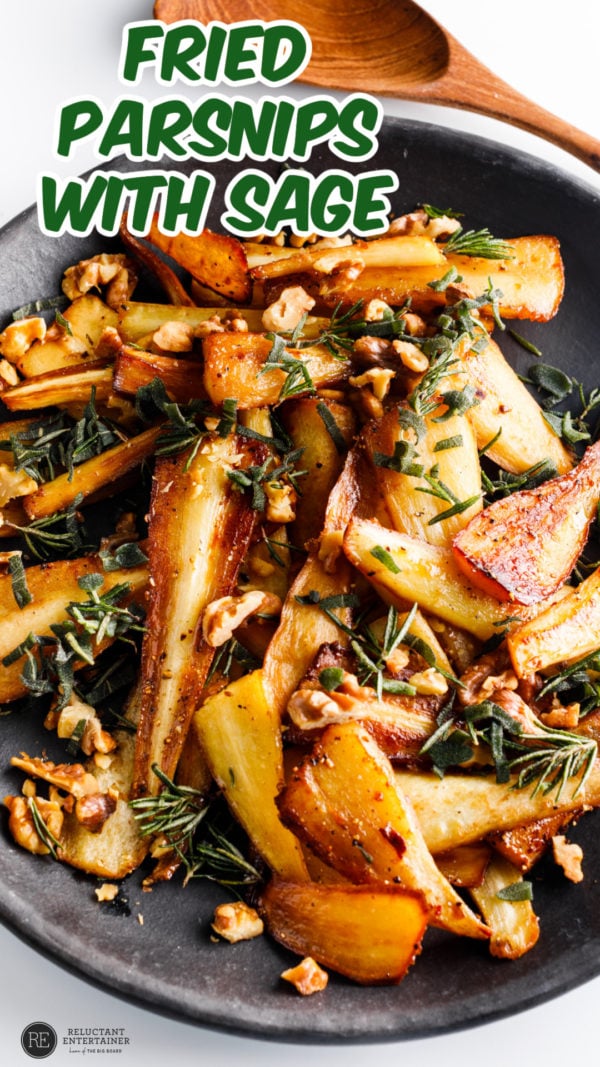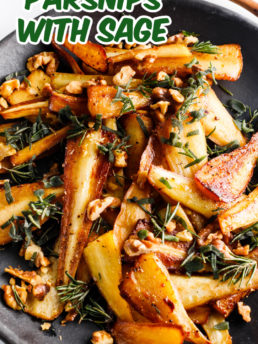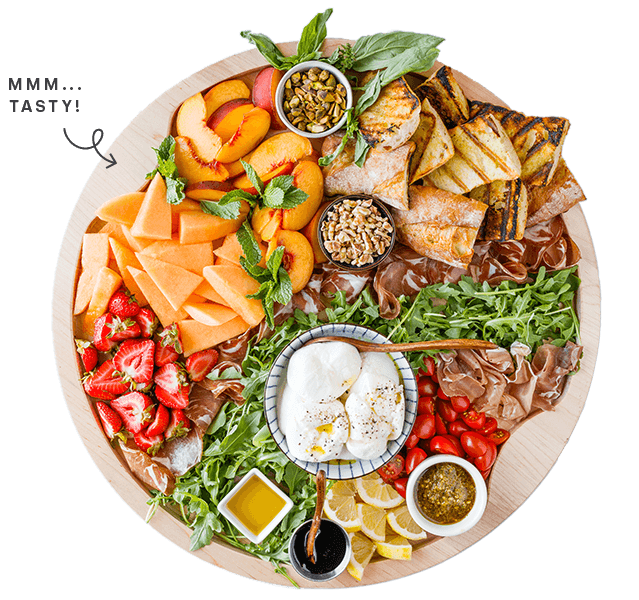Fried Parsnips with Sage
Can you fry parsnips? Yes, you can, for the best Fried Parsnips with Sage recipe, with a golden, sweet glaze to make an incredible winter side dish!

Parsnips can be a tricky vegetable to prepare. Often they’re pretty fibrous and have a strong, evergreen-like flavor. But these fried parsnips have just the right mix of earthiness, in herb-infused oil, and then cooked in a honey-butter glaze until they are caramelized.
Fried Parsnips with sage
They make the best side dish for any holiday or cozy gathering. Mix up the nuts and herbs for your favorite flavors! If you want to try roasting them, try our Roasted Carrots and Parsnips with Thyme recipe.
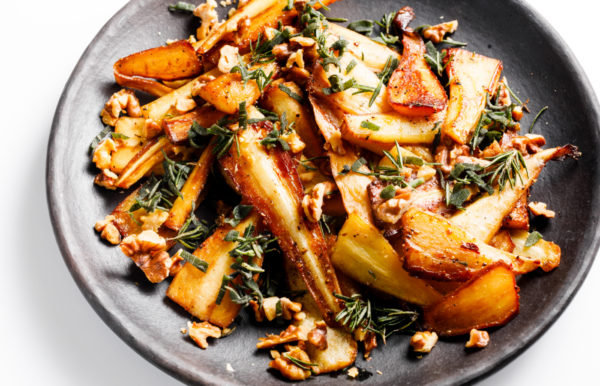
Why we love pan-fried parsnips with sage
The sweet and herby flavors compliment the parsnips so well, that this recipe will convert any parsnip hater into a lover. I promise!
This recipe is a quintessential fall and winter dish that’s delicious for the holidays, served with ham, prime rib, turkey, Cornish game hens!
The secret is to thinly slice them with a mandolin!
What we also love about side dishes, like carrots and parsnips, is they don’t take a lot of ingredients.
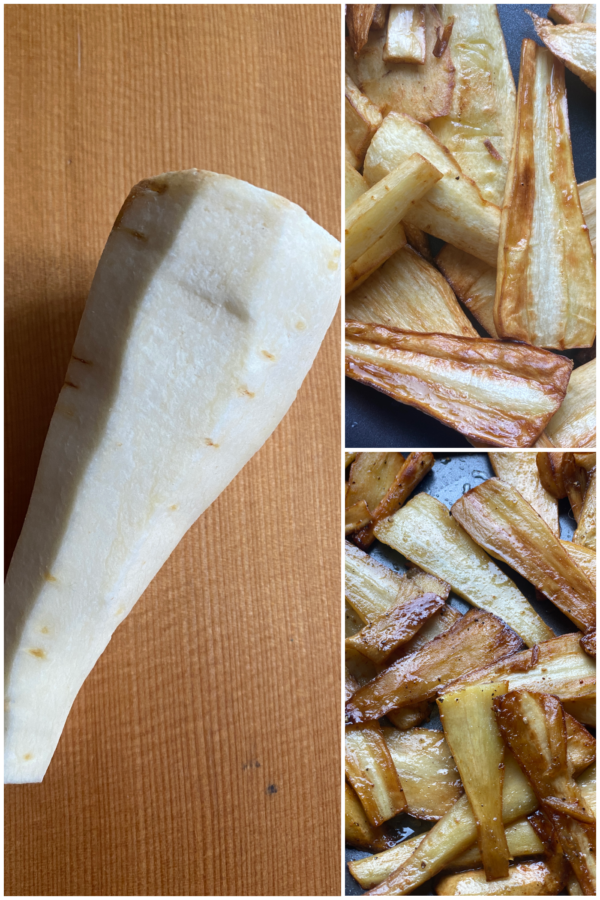
Ingredients for pan-fried parsnips
- Avocado oil: or use canola, grape seed, or vegetable oil
- Packs of fresh sage leaves
- Fresh rosemary
- Parsnips
- White wine
- Honey
- Butter
- Toasted chopped walnuts: optional to use chopped almonds or pecans
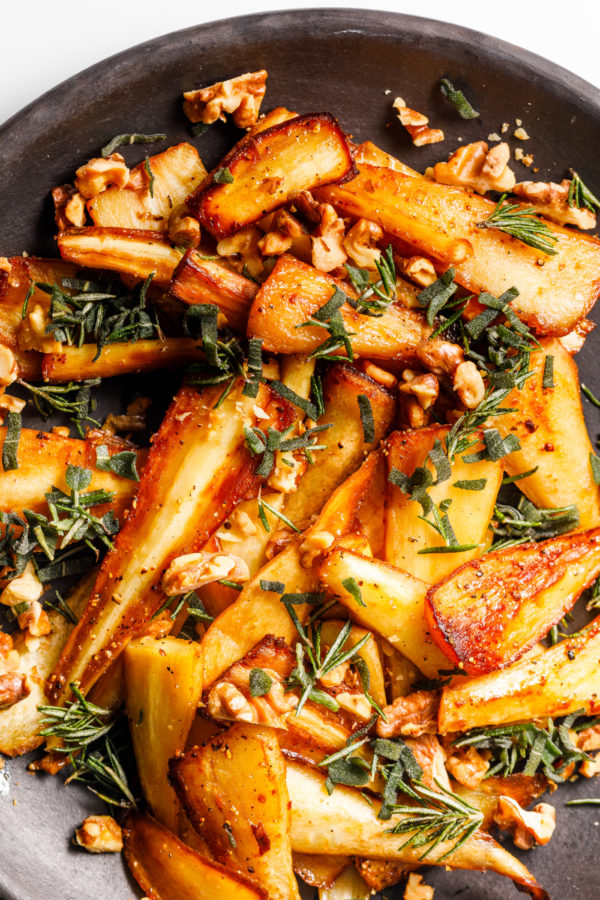
This beautiful side of roasted root vegetables pairs so well with holiday main dishes. And we also love them left over in a salad the next day. They’re delicious served with this Kale and Beet Salad, too. The hint of sage just gives the best flavor!

How do you fry parsnips?
- In a medium skillet, heat the oil over medium-high heat, making sure there is enough to cover the bottom of the pan. As the oil heats, prepare a bowl with a fine mesh sieve on top to drain the oil when the sage and rosemary are done cooking (you don’t want to be frantically trying to put this together and risk burning the sage or your hands).
- Once the oil is shimmery, add the sage and rosemary and stir frequently, until parsnips have stiffened and slightly darkened in color. Drain into the sieve, reserving the oil, then transfer the fried herbs to a paper towel, season with a pinch of salt and let sit.
- Add the oil back to the skillet and heat over high. Once you see wisps of smoke, carefully add 1/3 of the parsnips to the oil, and cook until golden on both sides. Remove from the oil, transfer to a paper towel-lined plate, and season lightly with salt. Repeat with remaining parsnips (working in 2 more batches).
- Once the parsnips are all cooked, transfer to a larger, 12’’ skillet with the butter, honey, and salt to taste. Bring the heat to medium-high and allow the butter and honey to melt.
- Add the white wine and cook, stirring frequently, until reduced. Finally add the walnuts.
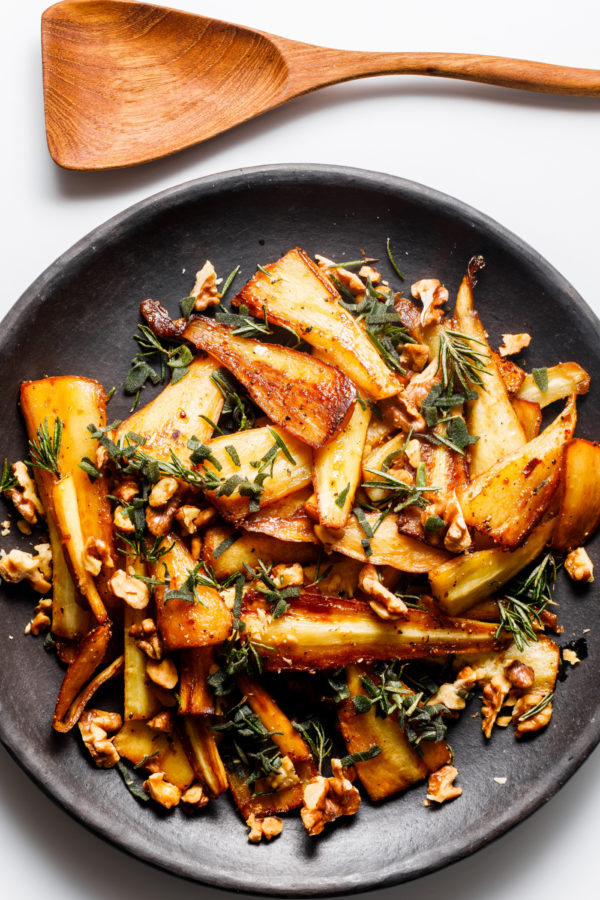
Tips and substitutions:
- Do parsnips need parboiling before roasting? No, you do not need to parboil parsnips before baking, roasting or pan-frying. However, the parboiling process does soften the parsnips to make them less chewy for some recipes. There is no need to for this recipe.
- Should I peel my parsnips before roasting? Baby parsnips (or smaller ones) don’t really need peeling. We just scrub them and keep the peel on. Older parsnips should be peeled, like you would a carrot, with a peeler or sharp knife. They are tougher, and the central core is very fibrous.
- I use avocado oil to fry the herbs and the parsnips, because it has a high smoke point and neutral flavor. Optional to use canola, vegetable, or grape seed, oil.
- To get parsnips into plank shape, trim off the very top and the skinny, fibrous tail. Then, use a mandolin set to 1/4’’ or cut a long, thin, flat piece off the side of the parsnip (lengthwise), and roll it so it sits flat on the cutting board and doesn’t roll as you cut it into planks. You can purchase a mandolin, here.
- This recipe used two pans, a medium and larger one. The herbs and parsnips are fried in a smaller skillet, to allow the ingredients to fry and submerge in the hot oil to fry properly. The parsnips are then transferred to a larger skillet to finish cooking with the glaze, to allow for more room to toss in the butter and honey.
- How do you serve parsnips? Garnish the parsnips with the fried herbs and toasted walnuts and serve warm.
Whether they are for a holiday meal, a Sunday roast beef dinner, or a weeknight salad—these sweet, pan-fried parsnips are so good!

More winter side dishes you may want to try:
Vegetable Au Gratin with Brussels Sprouts
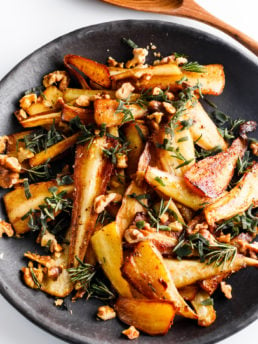
Get the Recipe:
Fried Parsnips with Sage
Ingredients
- ½ c Avocado oil
- 2 Tbsp Tbsp sage leaves, chiffonade (cut into thin,1/8’’thick ribbons)
- 3 Tbsp rosemary, torn into small, bite-sized sprigs (not chopped)
- 1 lb parsnips, sliced into 1/4’’ thick planks, about 8 small parsnips (see note)
- ⅓ c white wine
- 2 Tbsp honey
- 2 Tbsp butter
- 3 Tbsp toasted, chopped walnuts
Instructions
- In a medium skillet, heat the avocado oil over medium-high heat, making sure there is enough to cover the bottom of the pan. As the oil heats, prepare a bowl with a fine mesh sieve on top to drain the oil when the sage and rosemary are done cooking (you don’t want to be frantically trying to put this together and risk burning the sage or your hands).
- Once the oil is shimmery, about 350-375 degrees F, add the sage and rosemary and stir frequently for 30-60 seconds, until they have stiffened and slightly darkened in color. Drain into the sieve, reserving the oil, then transfer the fried herbs to a paper towel, season with a pinch of salt and let sit.
- Add the oil back to the skillet and heat over high. Once you see wisps of smoke, carefully add 1/3 of the parsnips to the oil, and cook about 3 minutes per side, until golden on both sides.
- Remove from the oil, transfer to a paper towel-lined plate, and season lightly with salt. Repeat with remaining parsnips (working in 2 more batches).
- Once the parsnips are all cooked, transfer to a larger, 12’’ skillet with the butter, honey, and salt to taste. Bring the heat to medium-high and allow the butter and honey to melt, 2 minutes.
- Add the white wine and cook, stirring frequently, until reduced, 5-7 minutes. Finally add the walnuts.
- Garnish the parsnips with the fried herbs and toasted walnuts and serve warm.
